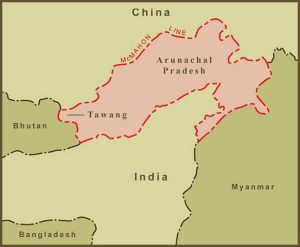From India Today
Ananth Krishnan | Posted by Sanjay Nirala
Beijing, March 2, 2017 | UPDATED 06:41 IST
India sees China as occupying 38,000 sq km of its territory in Aksai Chin, while China claims 90,000 sq km in Arunachal Pradesh.
 China’s long-time negotiator on the border talks, who retired in 2013, has said that Tawang in Arunachal Pradesh is an “inalienable” part of Tibet and that a boundary settlement would not be possible unless India agreed to make concessions in the eastern sector.
China’s long-time negotiator on the border talks, who retired in 2013, has said that Tawang in Arunachal Pradesh is an “inalienable” part of Tibet and that a boundary settlement would not be possible unless India agreed to make concessions in the eastern sector.
But if India did so, China would also make concessions in Aksai Chin, suggested Dai Bingguo, spelling out in detail for the first time his thoughts on a solution.
Dai, who was the Special Representative on the boundary issue for 15 rounds of talks until his retirement in 2013, said that India “held the key” to the settlement and that if it took into account China’s concerns in the eastern sector, Beijing would similarly do so in other areas.
THE DISPUTE
India sees China as occupying 38,000 sq km of its territory in Aksai Chin, while China claims 90,000 sq km in Arunachal Pradesh.
Dai, who recently penned his memoirs, told the Beijing-based China-India Dialogue magazine, published by the official China International Publishing Group, in an interview: “The disputed territory in the eastern sector of the China-India boundary, including Tawang, is inalienable from China’s Tibet in terms of cultural background and administrative jurisdiction.”
He said it was not until February 1951 that “the local government of Tibet [was] forced to stop its actual administration of Tawang”. “Even the British colonialists who drew the illegal ‘McMahon Line’ respected China’s jurisdiction over Tawang,” he said.

 Dai added: “The major reason the boundary question persists is that China’s reasonable requests [in the east] have not been met”.
Dai added: “The major reason the boundary question persists is that China’s reasonable requests [in the east] have not been met”.
“If the Indian side takes care of China’s concerns in the eastern sector of their border,” he said, “the Chinese side will respond accordingly and address India’s concerns elsewhere.”
Despite his emphasis on Tawang, Dai suggested that the 15 rounds of talks he participated in had moved both sides close to “a political settlement”. His comments suggest this would involve mutual adjustments or concessions, most likely in Tawang and Aksai Chin.
“China and India are now standing in front of the gate towards a final settlement,” he said. “The gate is a framework solution based on meaningful and mutually accepted adjustments. Now, the Indian side holds the key to the gate.”
The 19th round of talks was held between National Security Adviser Ajit Doval and State Councillor Yang Jiechi, Dai’s successor as SR, in Beijing last April.




 Print
Print Email
Email